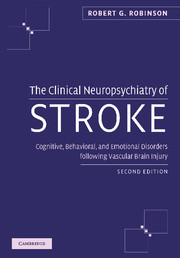 The Clinical Neuropsychiatry of Stroke
The Clinical Neuropsychiatry of Stroke Book contents
- Frontmatter
- Contents
- Preface
- Part I Introduction
- Part II Poststroke depression
- Part III Poststroke mania
- Part IV Poststroke anxiety disorders
- 29 Prevalence and specificity of clinical symptoms
- 30 Clinical and lesion correlates
- 31 Longitudinal course
- 32 Relationship of anxiety to outcome
- 33 Mechanism and treatment of poststroke anxiety disorder
- Part V Other poststroke disorders
- Index
29 - Prevalence and specificity of clinical symptoms
from Part IV - Poststroke anxiety disorders
Published online by Cambridge University Press: 01 October 2009
- Frontmatter
- Contents
- Preface
- Part I Introduction
- Part II Poststroke depression
- Part III Poststroke mania
- Part IV Poststroke anxiety disorders
- 29 Prevalence and specificity of clinical symptoms
- 30 Clinical and lesion correlates
- 31 Longitudinal course
- 32 Relationship of anxiety to outcome
- 33 Mechanism and treatment of poststroke anxiety disorder
- Part V Other poststroke disorders
- Index
Summary
Specificity of anxiety symptoms
In order to examine the frequency of anxiety symptoms and their specificity for anxiety disorder, patients with acute stroke were grouped according to whether they did or did not express anxiety or worry. As I discussed in Chapter 7 entitled, “Phenomenology and the specificity of depressive symptoms,” among patients with acute stroke, it is not obvious how one should assess the specificity of symptoms used for the diagnosis of anxiety disorder. If one uses the diagnostic criteria to define the study group, it becomes circular reasoning since the anxious patients are defined by the very criteria that are being assessed for specificity. On the other hand, if one groups patients based on the presence of anxiety or any other single symptom, the group would include patients who do not have the full syndrome of generalized anxiety disorder (GAD) but merely one or two symptoms.
The criteria we have chosen is the second method which includes all patients who acknowledge the presence of anxiety or worry. By dividing patients based on the presence or absence of a single symptom (i.e., anxiety or worry) our studies include some patients without the full syndrome of GAD which, therefore, decreases the likelihood of finding symptoms that are specific for anxiety disorders.
- Type
- Chapter
- Information
- The Clinical Neuropsychiatry of StrokeCognitive, Behavioral and Emotional Disorders following Vascular Brain Injury, pp. 319 - 325Publisher: Cambridge University PressPrint publication year: 2006


